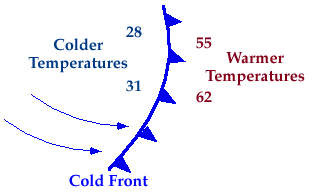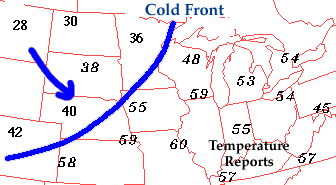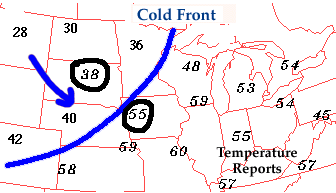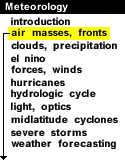
|
A cold front is defined as the transition zone where a cold air mass is replacing a warmer air mass. Cold fronts generally move from northwest to southeast. The air behind a cold front is noticeably colder and drier than the air ahead of it. When a cold front passes through, temperatures can drop more than 15 degrees within the first hour.

Symbolically, a cold front is represented by a solid line with triangles along the front pointing towards the warmer air and in the direction of movement. On colored weather maps, a cold front is drawn with a solid blue line.

There is typically a noticeable temperature change from one side of a cold front to the other. In the map of surface temperatures below, the station east of the front reported a temperature of 55 degrees Fahrenheit while a short distance behind the front, the temperature decreased to 38 degrees. An abrupt temperature change over a short distance is a good indicator that a front is located somewhere in between.

If colder air is replacing warmer air, then the front should be analyzed as a cold front. On the other hand, if warmer air is replacing cold air, then the front should be analyzed as a warm front. Common characteristics associated with cold fronts have been listed in the table below.
| Before Passing | While Passing | After Passing | ||||
|---|---|---|---|---|---|---|
| Winds | south-southwest | gusty; shifting | west-northwest | |||
| Temperature | warm | sudden drop | steadily dropping | |||
| Pressure | falling steadily | minimum, then sharp rise | rising steadily | |||
| Clouds | increasing: Ci, Cs and Cb | Cb | Cu | |||
| Precipitation | short period of showers | heavy rains, sometimes with hail, thunder and lightning | showers then clearing | |||
| Visibility | fair to poor in haze | poor, followed by improving | good, except in showers | |||
| Dew Point | high; remains steady | sharp drop | lowering |

Fronts |
|

wind shift |





